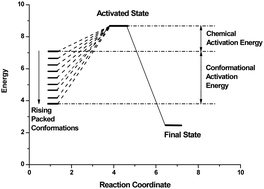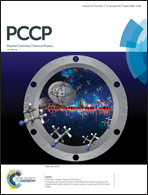Reactions driving conformational movements (molecular motors) in gels: conformational and structural chemical kinetics
Abstract
In this perspective the empirical kinetics of conducting polymers exchanging anions and solvent during electrochemical reactions to get dense reactive gels is reviewed. The reaction drives conformational movements of the chains (molecular motors), exchange of ions and solvent with the electrolyte and structural (relaxation, swelling, shrinking and compaction) gel changes. Reaction-driven structural changes are identified and quantified from electrochemical responses. The empirical reaction activation energy (Ea), the reaction coefficient (k) and the reaction orders (α and β) change as a function of the conformational energy variation during the reaction. This conformational energy becomes an empirical magnitude. Ea, k, α and β include and provide quantitative conformational and structural information. The chemical kinetics becomes structural chemical kinetics (SCK) for reactions driving conformational movements of the reactants. The electrochemically stimulated conformational relaxation model describes empirical results and some results from the literature for biochemical reactions. In parallel the development of an emerging technological world of soft, wet, multifunctional and biomimetic tools and anthropomorphic robots driven by reactions of the constitutive material, as in biological organs, can be now envisaged being theoretically supported by the kinetic model.

- This article is part of the themed collection: PCCP Perspectives

 Please wait while we load your content...
Please wait while we load your content...